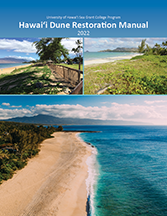The Hawaiʻi Dune Restoration Manual was written and created by the University of Hawaiʻi Sea Grant College Program (Hawaiʻi Sea Grant). Hawaiʻi Sea Grant supports and conducts innovative research, education, and extension services toward the improved understanding and stewardship of coastal and marine resources nationwide.
The Hawaiʻi Dune Restoration Manual is written in response to increasing awareness of the importance of preserving, restoring, and maintaining coastal dunes. There are clear ongoing impacts associated with climate change, including sea-level rise, coastal flooding, and more frequent and severe storm events, all causing beach and dune erosion. However, there are also direct human impacts on coastal dunes from coastal development and recreation, and a demonstrated need to address foot traffic erosion in high impact areas, like public beach parks. Proactive coastal dune restoration, coupled with responsible coastal development, will be crucial to protecting Hawaiʻi’s iconic beaches and dunes, shorefront infrastructure, and nearshore cultural and natural resources. Healthy coastal dunes are essential components that enable shorelines to adapt naturally to changing climate and ocean conditions, and contribute to the resiliency of coastal communities.
This manual is intended for use by community groups, nonprofits, county and state agencies and departments, coastal resorts and condominiums, coastal landowners and managers, and anyone interested in conducting proactive dune restoration projects in partnership with Hawaiʻi Sea Grant community extension agents. It is important to note, however, that dune restoration may not be appropriate at all locations and is closely regulated by state and county resource agencies (Appendix B). Before initiating a project, it is advisable to consult with a professional or contact your local Hawaiʻi Sea Grant extension agent for advice and guidance (Appendix A).
The beaches and coastal ecosystems of the Main Hawaiian Islands are incredibly diverse and represent a striking number of climates, geologic conditions, and local coastal processes. This diversity presents an inherent challenge when attempting to provide broadly applicable guidance and best management practices for dune restoration statewide. We hope that this guide will be used in collaboration with local practitioners and experts, and will provide a starting point for conducting restoration activities. However, it is not intended to replace place-based knowledge or the practical, on-the-ground experience of local restoration practitioners and land managers. While dune restoration is a powerful tool in the nature-based, coastal ecosystem restoration toolkit, it does not apply to every situation and location.
Read the manual HERE


